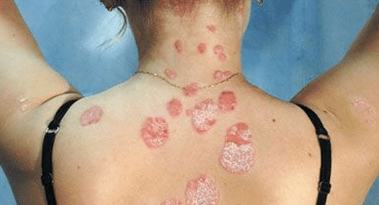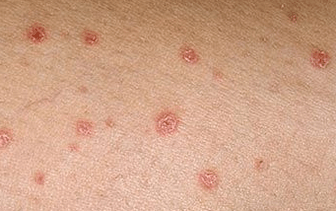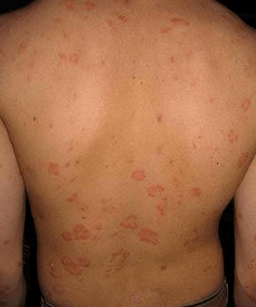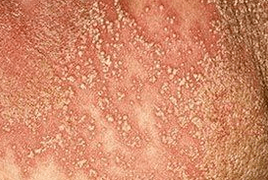Psoriasis is a chronic non-infectious disease, dermatosis, which mainly affects the skin.Currently, the autoimmune nature of this disease is assumed.Typically, psoriasis manifests itself in the formation of red, excessively dry and raised spots on the surface of the skin, so-called papules, which merge with each other to form plaques.These papules are by nature sites of chronic inflammation and excessive proliferation of lymphocytes, macrophages and keratinocytes of the skin, as well as excessive angiogenesis (formation of new small capillaries).

It occurs with equal frequency in men and women and lasts for years with alternating periods of relapses and remissions.This is one of the most common dermatoses, difficult to treat and often serious.
What is psoriasis?
Psoriasis is a widespread chronic skin disease characterized by a monomorphic eruption of flat papules that tend to coalesce into large plaques that quickly become covered with loose, silvery-white scales.
Psoriasis is characterized by periods of deterioration (relapses) and temporary well-being, when the manifestations of the disease become less severe.This disease is not infectious and the patient does not represent any danger to others.Because the appearance of psoriasis is not associated with microorganisms.
The main element of psoriasis is a single pink or red papule, which is covered by a large number of loose silvery-white scales.
As a general rule, psoriasis does not alter the usual rhythm of life of the sick person.The only drawback is peeling and inflammatory processes on the skin.Unfortunately, it is impossible to cure this disease, but it is quite possible to stop its development or prevent relapses.To do this, it is enough to follow all the doctor's prescriptions and undergo systematic treatment in a hospital.
Is psoriasis contagious?
Psoriasis is not at all contagious.Not a single case of human-to-human transmission of the disease has been recorded.The causative agents of the disease are not infections or microbes potentially dangerous to others, but leukocytes produced by the patient's body.
It is impossible for a healthy person to contract psoriasis from a patient.Psoriasis is not transmitted:
- In case of contact with the skin, by using the same household items as the patient (bed linen, towels, dishes).
- Through saliva, sweat.
- Sexually.
- When caring for the sick.
- Through the blood.
Classification
Experts distinguish two ways:

Non-pustular form of psoriasis
What is it?This form of the disease differs from others in its stable course.The non-pustular form of psoriasis is characterized by damage to almost the entire surface of the body.This type includes:
- erythrodermic psoriasis
- vulgar, ordinary or tabula.
Common psoriasis occurs quite frequently;Up to 90% of psoriasis patients are patients with the vulgar form of this disease.
Psoriatic erythroderma is a serious disease that often leads to death - the death of the patient.With the disease, a violation of the thermoregulation function occurs and the barrier function of the skin is reduced.
pustular
- Zumbusch pustular fundus or generalized pustular
- palmoplantaris (pustular psoriasis of the extremities, chronic persistent palmoplantaris pustulosis)
- annularly pustular
- palmoplantar
- psoriatic herpetiform impetigo
| Stage of psoriasis | Damage percentage |
| Light | less than 3% of the skin is affected |
| Average | 3 to 10% of the skin is covered with psoriatic plaques. |
| heavy | there are joint lesions or more than 10% of the skin is affected. |
How psoriasis starts: first signs
In most cases, identifying psoriasis is quite simple, because the disease does not look like other skin pathologies.Allergic rashes are smaller in size compared to psoriasis spots, and medical history shows that patients practically do not suffer from skin swelling, as occurs with allergies.
The initial symptoms and signs of psoriasis differ in the main characteristics that the doctor will base on when making a diagnosis:
- the appearance of a limited pink spot of varying intensity;
- itchy skin in the area of psoriatic lesions;
- exfoliation of large amounts of epidermis of various sizes;
- characteristic whitish peeling color;
- the appearance of clustered whitish or gray crusts that do not extend beyond the limits of the psoriatic spot;
- dry skin.
Psoriasis is characterized by three distinctive features:
- "Effect of stearic staining".When scraping the plate, small, transparent flakes easily come off.
- "Terminal film effect".If you remove the scales, the skin in this area will be thin, shiny and red.
- "The bloody dew effect."After scraping, small drops of blood appear on the skin.
Causes
Experts cannot identify the sole and exact culprit of the disease, but repeated studies show that the disease is autoimmune, that is, it depends on the functioning of the immune system.
For some unknown reason, immune cells, designed to protect the body from malignant changes and bacterial and viral damage, penetrate into the upper dermal layers and produce substances that trigger the inflammatory process.The result of this activity is proliferation: accelerated division of skin cells.

According to another theory, psoriasis develops due to a disturbance in the life cycle of keratinocytes.
Possible causes of psoriasis:
- Inheritance.According to the latest data from scientists, psoriasis is classified as a genotypic dermatosis with a dominant type of transmission.
- Violation of lipid, protein and carbohydrate metabolism.When skin psoriasis is suspected, changes in these blood profiles often occur, contributing to the development of cardiovascular pathology, endocrine dysfunction, and metabolic syndrome.
- The presence of a chronic infectious focus in the body.When examining psoriatic plaques, streptococcal flora is often detected.The appearance of genetic abnormalities can be influenced by viral and bacterial infections, for example, tonsillitis and influenza.
- Climatic conditions: dry and hot weather can affect the progression of psoriasis, intensify skin manifestations or, on the contrary, weaken them;
- Anxiety or stress: As mentioned above, excessive exertion due to stress directly affects the course of psoriatic disease;
- Damage to the skin: wounds facilitate infection and this leads to intoxication of the body due to inflammatory processes, so the appearance of psoriasis can cause minor damage, but provided that there are concomitant diseases;
- Infections: psoriasis outbreaks can be caused by the presence of pathogenic purulent inflammatory areas, especially in pathologies in childhood.
One theory suggests the existence of two variants of the disease:
- Psoriasis type I– is inherited in the presence of an immunological factor, more than 60% of all patients under 30 years of age suffer from this form, the prognosis is good, treatment is carried out for life.
- Psoriasis type II– occurs more frequently after the age of 45, is not associated with dysfunctions of the immune system, most often affects the nail plates and joints.
Symptoms of psoriasis
Skin psoriasis can develop at any age.But often the first case of its manifestation occurs in young people and adults from 18 to 40 years old.There are no differences by gender.Men and women suffer from this disease with equal frequency.
| Signs of psoriatic papules | |
| Form | round |
| edges | clear |
| Color | deep pink or red |
| Scale color | silver white |
The first rashes, as a rule, form at the site of wounds, scratches, frostbite, burns and on areas of the body that are constantly exposed to friction.They may itch, but this is not the main symptom.
Depending on the characteristics of the rash, the following forms of psoriasis are divided:
- Spot psoriasis: the size of the elements is smaller than the head of a pin.
- Teardrop-shaped: The papules are tear-shaped and reach the size of a lentil grain.
- Coin-shaped - the plates grow up to 3-5 mm and have rounded edges.
Eruption shapes are also distinguished when their elements look like rings, arches and garlands, geographical maps with jagged edges.

The general clinical picture and symptoms of psoriasis vary significantly depending on the stage of the disease.Dermatologists distinguish 3 stages that develop sequentially:
- Progressive.New skin lesions constantly appear, and there is also an active spread of existing plaques with severe peeling and itching.
- Stationary.The growth of papules on the body stops slightly, new formations do not appear, but thickened folds appear on the surface of the skin, near the plates.
- Coming back.No spread of disease or increased peeling is observed.As the signs of psoriasis disappear, areas of significant pigmentation remain on the body.
The alternation of these stages gives rise to the wave nature of relapses and remissions.A patient may have different stages of the disease in different areas of the skin.
The onset of psoriasis is expressed in the appearance of papules, which are small scaly nodules.They have a dark pink color, are dense to the touch and slightly protrude from the surface of the skin.
The first sign of psoriasis may be the appearance of a rash in areas of the body that are most likely to be subject to friction, and the skin in these areas is dry.These are the places:
- palms or elbows;
- below the knees;
- pimples;
- lateral parts of the lower back;
- inguinal folds;
- scalp.
The initial stage of psoriasis on the skin is barely noticeable and does not cause discomfort to the patient.But it is early treatment that will help avoid severe forms of this disease, in which the nails of the hands and feet, mucosal surfaces, and then the human joints are affected.
According to statistics, psoriatic plaques are most often located:
- on the outer surface of the joints;
- on the back and stomach;
- on the front of the thighs and forearms.
This is different from eczema, where the rash affects the inside of the limbs and the folds between the fingers.























